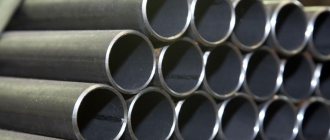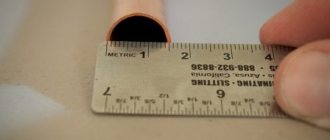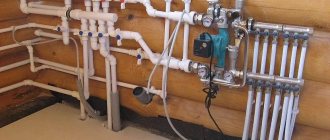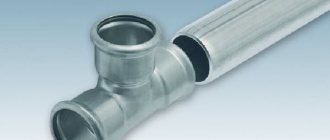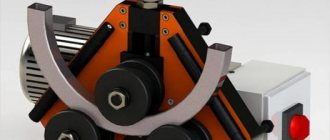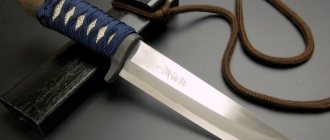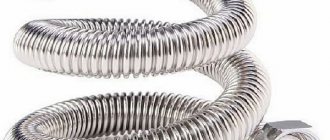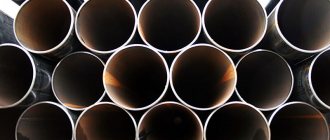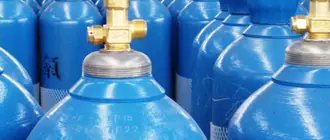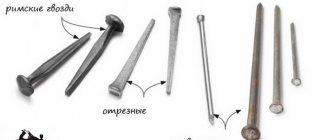Straight-seam electric welded pipes
The main area of application for longitudinal welded pipes is process pipelines designed for medium internal pressure, but if necessary they are quite suitable for the installation of metal structures.
The standard for steel pipes produced by this method is determined as follows:
- Technological features of the production of longitudinally welded pipes are regulated by GOST 10704-91;
- According to the standard, the outer diameter of this type of pipe can vary from 10 to 1420 mm, and the wall thickness - from 1 to 32 mm;
- Products with a diameter of up to 426 mm can be produced in both measured and unmeasured formats, and the length of a steel pipe with a larger diameter can only be unmeasured;
- In addition to ordinary pipes, production can also create products that have a reinforced weld, but in this case, GOST 10706 will regulate the production process and the dimensions of the pipes.
There is another important point regarding steel pipes - a straight seam can be created using argon arc welding or induction welding. In the first case, a more reliable connection is obtained, but the second method is much cheaper and faster.
Standards for Thick Walled Products
Thick-walled seamless steel pipe GOST 8732 is a high-strength product used for the construction of all kinds of metal structures or transportation of gases and liquids under high pressure. Welded products are used less frequently; preference is given to seamless pipes, and steel of different grades is suitable for this.
To prevent the inside of the pipe from rusting (important for supplying liquids of a certain chemical composition), thick-walled products are made from non-ferrous metals or are nickel-plated on the inside. They are used in the chemical industry and for transporting liquids from great depths.
Visually this is almost always noticeable, but there are standards by which thick-walled products are produced - within the range of 6mm - 12.5mm. If the hole inside is small and the wall is impressive, then these are especially thick-walled pipes. They are produced only by hot method.
The quality indicators of thick-walled pipes classify them according to the main standards: “B”, “C”, “D”:
- “B” - standardization of the chemical composition of the metal, including GOST 19281-89, GOST 4543-71, GOST 1050-88 and 8732-70;
- “B” - standardization of thermal indicators;
- “D” - without special regulation, but with internal pressure tests.
Thick-walled pipes bend poorly, but they are products of increased strength and resistance to mechanical stress. Their main function is to transport gaseous and liquid media under pressure. But they are also indispensable as frost-resistant building materials; large-format welded products are also suitable for this. These products are subject to the requirements of GOST 8732-78 and TU 14-3-1128-2000. To produce workpieces with thick walls, the following steel grades are usually used:
- 10G2;
- 09G2S (low alloy alloy for welded structures, silicon and carbon up to 1% and 2% manganese).
Welding of pipes with a seam is carried out with or without preheating. The less carbon in the steel grade, the easier the welding. When welding, the steel does not overheat, does not harden, and the viscosity does not decrease. And the alloy’s resistance to low temperatures makes it possible to effectively use 09G2S products even in the Far North.
Seamless hot-formed pipes
The specifications for the lengths of steel pipes of this type are as follows:
- The production technology and standard sizes of hot-deformed pipes are regulated by GOST 8732-78;
- The outer diameter varies from 20 to 550 mm, and the wall thickness can range from 2.5 to 75 mm;
- Pipes can have measured and unmeasured lengths, which vary from 4 to 12.5 meters.
The dimensions of seamless steel pipe produced by this method may differ from standard ones. In extreme cases, a calibrated blank is taken, a through hole is drilled inside of it, and the result is a pipe with especially thick walls.
Dimensions
The range of seamless pipes is determined in accordance with the requirements of GOST for cold- and hot-rolled products. The standards used in this case have many similarities. The only difference is the difference between the mechanical parameters. It arises due to the fact that each method has its own special production cycle.
The size range of seamless products manufactured by the hot-rolled method consists of the following types:
- unmeasured length – 15-100 cm;
- measured length – 15-100 cm, deviation of no more than 15 mm is allowed;
- multiple measured value - within the measured length, taking into account an allowance of 5 mm for each cut. There are also established limits for permissible deviations that correspond to 15 mm, provided that the minimum multiple length of the product is at least 300 mm;
- limited length - within the limits of the measured value with a permissible deviation of 500 mm.
The current standards of GOST 5632 allow the introduction of microadditives in the form of rare earth metals. However, a requirement is immediately specified that the level of sulfur in the steel alloy cannot exceed 0.02%. Non-compliance with standards is fraught with loss of a number of operational parameters.
Regarding cold-rolled seamless pipes, the dimensions directly depend on the wall thickness:
- 0.5 mm – minimum length is 0.75 m, maximum – 7 m;
- 0.5-1 mm – 1-7 m;
- over 1 mm – 1.5-12.5 m.
Regarding the production of products of unmeasured or multiple dimensional sizes, the dimensional requirements correspond to similar standards that are observed when producing hot-rolled pipes.
Specifications
The technical parameters of the product directly depend on the production method and the grade of steel alloy used. They are also regulated by GOST requirements.
For products manufactured by hot deformation, GOST 8732-78 establishes the following standards:
- wall thickness – 2.5-75 mm;
- mass per unit length of the product - corresponds to the diameter and wall thickness;
- diameter – 20-530 mm;
- permissible curvature deviations are 1.5-4 mm.
Regarding pipes obtained as a result of cold rolling, the rules are determined by GOST 8734-75:
- wall thickness - 0.3-24 mm;
- mass per unit length - indicated in a special table in the regulatory document;
- diameter – 5-250 mm;
- deviations in the curvature of the product are 1-3 mm.
Seamless steel pipe GOST 8732-78, GOST 8734-75
View price - Pipe BS
Seamless steel pipe GOST 8732-78, GOST 8734-75 - a pipe made from a steel billet without longitudinal and transverse seams.
Seamless pipes are used in pipelines and boiler plants, machines and units; in shipbuilding, automotive and aircraft industries. When it is impossible to use welded pipes, seamless ones are used, because... the latter are distinguished by high strength, quality and durability, wear resistance and are able to work in operational conditions. Increased strength is important when water flows through the pipeline at high pressure and temperature. Seamless pipes also have increased anti-corrosion properties - a special coating that protects against aggressive influences. Production of seamless pipes.
There are 4 methods for producing seamless pipes: rolling, drawing, forging and pressing. Seamless pipes , according to the manufacturing method and production temperatures, are: hot-deformed (rolled in a hot state) , heat-deformed (steel is heated to a temperature not exceeding the recrystallization temperature) and cold-deformed (rolled without preheating); by wall thickness: thick-walled and thin-walled .
Hot-deformed seamless steel pipes GOST 8732-78
- Seamless steel pipes for general purpose, manufactured according to outer diameter, wall thickness and length.
The production of seamless hot-deformed steel pipes occurs by hot rolling, after which the pipes are subjected to additional cold rolling. These pipes have increased strength and heat resistance, and therefore this type of pipe is used when installing pipelines with water, gas, steam or oil products. They are also widely used in aircraft and mechanical engineering, and in the construction of boiler structures.
The mass of 1 m of pipes is calculated by the formula: M = 0.02466 x S (Dn - S), where Dn is the outer diameter, mm; S - wall thickness, mm
Assortment of hot-deformed seamless steel pipes
The outer diameter of these pipes ranges from 25 to 700 mm inclusive. Wall thickness ranges from 2.5 mm to 75 mm. Seamless hot-formed steel comes in different thicknesses and diameters. Depending on the ratio of these quantities, pipes are distinguished: extra-thin-walled, thin-walled, thick-walled, extra-thick-walled.
Along the length of the pipe, seamless hot-deformed pipes are manufactured:
- unmeasured length (4-12.5m)
- measured length - within unmeasured
- length, a multiple of the measured length - within the unmeasured length with an allowance for each cut of 5 mm
- approximate length - within unmeasured length
Seamless hot-deformed pipes are represented by steel: steel 10, st 20, st35, st 45, st40Kh, st09G2S, 30KhGSA. The curvature of any section of the pipe per 1 m of length should not exceed: - 1.5 mm - for pipes with a wall thickness up to 20 mm - 2.0 mm - for pipes with a wall thickness above 20-30 mm - 4.0 mm - for pipes with a wall thickness more than 30mm.
Buy seamless pipe
From us you can purchase seamless pipes from all manufacturers from branch warehouses, warehouses in the Moscow region or directly from the factory. We provide pipe cutting, delivery and assembly services. the availability, range and price of seamless pipes on our website. It should also be taken into account that the price of metal depends on the required quantity. More detailed information on the price per 1 meter or per length, clarify the weight of the seamless pipe and make a quantity calculation , issue an invoice and fill out an application , clarify payment options and request a certificate for a seamless pipe - you can contact the manager by contacting him at
(8452) 57-00-18, e-mail: [email protected]
Table . Seamless hot-deformed steel pipe. Dimensions, main diameters and thicknesses of seamless hot-deformed pipe according to GOST 8732-78. Weight of 1m of pipe, number of meters per ton .
Cold-deformed seamless steel pipes GOST 8734-75 - seamless steel pipes with a diameter of 5 to 250 mm, produced by cold rolling. Seamless cold-deformed pipes are used for pipelines, boiler equipment, machine parts, structures and other products, in shipbuilding and mechanical engineering, where the accuracy and quality of the material is important.
The most popular are pipes with an outer wall diameter from 8 to 450 mm; the wall thickness can reach 20 mm. Depending on the thickness of the outer diameter (Dн) to the wall thickness (s), the pipes are made:
- extra-thin-walled with Dн/ s more than 40 and pipes with a diameter of 20 mm or less with a wall of 0.5 mm or less,
- thin-walled with Dн/s from 12.5 to 40 and pipes with a diameter of 20 mm or less with a wall of 1.5 mm,
- thick-walled with Dн/s from 6 to 12.5,
- extra-thick-walled with Dн/ s less than 6.
The length of seamless cold-deformed pipes is from 1.5 m to 11.5 m, depending on the diameter and wall thickness. The range of steel grades for the manufacture of these pipes is extensive: steel 10, seamless pipes steel 20 , 35, 45, 10G2, 15Х, 20Х, 40Х, 30ХГСА, 15ХМ in accordance with GOST 1050, GOST 19281-89, GOST 4543-71.
In each batch of pipes of measured length, no more than 5% of pipes of unmeasured length and shorter than 2.5 m are allowed
Dimensions, main diameters and thicknesses of seamless cold-deformed pipe according to GOST 8734-75, weight of 1 m of pipe, number of meters per ton can be found in GOST 8734-75 .
How to accurately calculate how many VGP pipes are needed and what length
The cost of VGP pipes is determined by weight. But when purchasing, the main indicators of interest to the customer will be the length, wall thickness and throughput (conditional passage) of the steel product. To calculate the number and weight of pipes, it is necessary to take into account the design dimensions of the future pipeline, the pressure that will be exerted on the walls, and the scope of use.
Reference. With different characteristics of pipes, a linear meter will have a different weight.
To correctly calculate the required number of pipes and select the footage, you need to contact professionals. GOST Metal specialists will help you make the right choice.
Leave a request to calculate the number of pipes for an existing project or call today. Our company has been shipping GOST pipe products from leading manufacturers for more than 10 years. We also provide cutting services and delivery from warehouses in the Moscow region using our own transport. Pickup available.
Pipe classes
Steel pipes are divided into 6 main classes:
Class 1 - standard and gas pipes , which are used where there are no strict requirements for their quality. They are used for the manufacture of scaffolding, various fences, supports and irrigation systems. They are also used to supply liquid and gaseous substances.
Class 2 - used for installation of main pipelines in which gas, water, oil and petroleum products or fuel are supplied under low or high pressure.
Class 3 - used in systems that operate under high pressure or at high temperatures . For example: heating stations, oil pipelines or furnaces, chemical and food industries.
Class 4 - used for exploration of oil fields, installation of drilling and casing structures .
Class 5 ( structural class ) - used in automobile and carriage building, in steel structures: cranes, masts, supports and even in the production of furniture .
Class 6 - used in mechanical engineering in the manufacture of pump pistons, cylinders and other parts.
See also: Steel grades according to GOST, AISI, ASTM, ASME, En, DIN, WNr.
GOSTs and specifications for rolled pipes
The produced range, dimensions, characteristics and use of rolled pipe products are regulated by state standards (GOST) and technical conditions (TU).
For electric welded pipes
- GOST 3262-75 — Steel water and gas pipes.
- GOST 10704-91 — Electric-welded straight-seam steel pipes. Assortment
- GOST 10705-80 — Electric-welded steel pipes. Specifications
- GOST 10706-76 — Electric-welded straight-seam steel pipes. Technical requirements
- GOST 20295-85 — Welded steel pipes for main gas and oil pipelines
For seamless pipes
- GOST 8731-74 — Seamless hot-deformed steel pipes. Technical requirements
- GOST 8732-78 — Seamless hot-deformed steel pipes. Assortment
- GOST 8733-74 — Cold-deformed and heat-deformed seamless steel pipes. Technical requirements
- GOST 8734-75 — Seamless cold-deformed steel pipes. Assortment
- TU 14-3-460-2009 — Seamless steel pipes for steam boilers and pipelines. Specifications
- TU 14-3R-55-2001 — Seamless steel pipes for steam boilers and pipelines. Specifications
- GOST 9940-81 — Seamless hot-deformed pipes made of corrosion-resistant steel. Specifications
- GOST 9941-81 — Cold- and heat-deformed seamless pipes made of corrosion-resistant steel. Specifications
- GOST 9567-75 — Precision steel pipes. Assortment
For profile pipes
- GOST 8639-82 — Square steel pipes. Assortment
- GOST 8645-68 — Rectangular steel pipes. Assortment
- GOST 13663-86 — Profile steel pipes. Technical requirements
- GOST 30245-2003 — Bent closed welded square and rectangular steel profiles for building structures. Specifications
- TU 14-105-737-2004 — Electric-welded straight-seam steel pipes of round and profile sections. Specifications
Standards for Thick Walled Products
Thick-walled seamless steel pipe GOST 8732 is a high-strength product used for the construction of all kinds of metal structures or transportation of gases and liquids under high pressure. Welded products are used less frequently; preference is given to seamless pipes, and steel of different grades is suitable for this.
To prevent the inside of the pipe from rusting (important for supplying liquids of a certain chemical composition), thick-walled products are made from non-ferrous metals or are nickel-plated on the inside. They are used in the chemical industry and for transporting liquids from great depths.
Visually this is almost always noticeable, but there are standards by which thick-walled products are produced - within the range of 6mm - 12.5mm. If the hole inside is small and the wall is impressive, then these are especially thick-walled pipes. They are produced only by hot method.
The quality indicators of thick-walled pipes classify them according to the main standards: “B”, “C”, “D”:
- “B” - standardization of the chemical composition of the metal, including GOST 19281-89, GOST 4543-71, GOST 1050-88 and 8732-70;
- “B” - standardization of thermal indicators;
- “D” - without special regulation, but with internal pressure tests.
Thick-walled pipes bend poorly, but they are products of increased strength and resistance to mechanical stress. Their main function is to transport gaseous and liquid media under pressure. But they are also indispensable as frost-resistant building materials; large-format welded products are also suitable for this. These products are subject to the requirements of GOST 8732-78 and TU 14-3-1128-2000. To produce workpieces with thick walls, the following steel grades are usually used:
- 10G2;
- 09G2S (low alloy alloy for welded structures, silicon and carbon up to 1% and 2% manganese).
Welding of pipes with a seam is carried out with or without preheating. The less carbon in the steel grade, the easier the welding. When welding, the steel does not overheat, does not harden, and the viscosity does not decrease. And the alloy’s resistance to low temperatures makes it possible to effectively use 09G2S products even in the Far North.
Spiral seam electric welded
Standard and sizes
- Spiral welded pipes are produced in accordance with GOST 8696-74;
- As you might guess, their main difference from straight-seam ones is that the flat workpiece is rolled into a pipe in the form of a spiral and boiled. This ensures the pipe's ability to withstand greater pressure;
- According to the standard, the dimensions of a steel pipe are as follows: outer diameter from 159 to 2520 mm, wall thickness 3.5 - 25 mm;
- Pipes are supplied in lengths from 10 to 12 meters.
Application
The standard specifically states that this standard does not apply to main pipes for oil and gas pipelines.
However, the difference concerns exclusively the range of pipes. From the point of view of the production method, spiral-welded pipes can be used for heating mains, water mains and oil and gas pipelines. This is what we are seeing.
Spiral welded pipe is also easy to recognize
